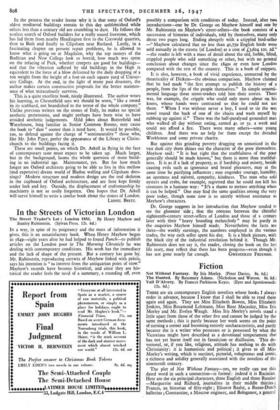Building at Oxford
Oxford Stone. By W. J. Arkell. (Faber and Faber. 25s.)
ARC.HITECTS nowadays work mostly in substitute materials, and feel about stone much the same as they feel about vintage claret. To them blocks of stone out of the earth have a sensuous splendour, and Dr. Arkell's book is as evocative as a pre-war Michelin guide. It is also one of those rare books which open up a whole new king- dom to the curious-minded, and give the confirmed sightseer a completely fresh line to follow up. The object of the book is to trace the new honey-coloured Oxford and the old crumbling black Oxford back to their quarries of origin.
"To these quarries for a thousand years the quarrymen came each morning up the white road from the village and made the valley ring with their hammers and axes, drowning the ceaseless song of the larks." In the process the reader learns syhy it is that some of Oxford's oldest mediaeval buildings remain to this day unblemished while others less than a century old are crumbling to dust. He follows the restless search of Oxford builders for a really sound freestone, which has led thcm from nearby Headington first to the Cotswold quarries, then to Bath and finally to Clipsham near Rutland. Lastly, in a fascinating chapter on present repair problems, he is allowed to know what is going on at Magdalen, why the top storeys of the Bodleian and New College look so horrid, how much was spent on the refacing of Peck, whether creepers are good for buildings— and that the vibration suffered by old buildings in the High is equivalent to the force of a blow delivered by the daily dropping of a ton weight from the height of a foot on each square yard of Univer- sity College. At the end, in the light of many past disasters, the author makes certain constructive proposals for the better mainten- ance of what miraculously survives.
This is a quite excellent book, nicely illustrated. The author wears his learning, as Chesterfield says wit should be worn, "like a sword in its scabbard, not brandished to the terror of the whole company." Unlike previous writers on the stones of Italy, he makes no special aesthetic pretensions, and might perhaps have been wise to have avoided aesthetic judgements. Mild jokes about Butterfield and Waterhouse, long familiar in Senior Common Rooms, may cause the book to " date" sooner than it need have. It would be possible, too, to defend against the charge of " sentimentality " those who, like Mr. John Piper, prefer th,e appearance of the Library at Christ- church to the buildings facing it.
These are small points, on which Dr. Arkell in flying in the face of contemporary taste must expect to be taken up. Much larger, but in the background, looms the whole question of stone build- ing in an industrial age. Maintenance, yes. But for how much longer are Oxford architects going to be able to live in this mellow (and expensive) dream world of Bladon walling and Clipsham dres- sings? Modern structure and modern design are the real skeleton in the cupboard of Oxford architecture, and are here kept firmly under lock and key. Outside, the displacement of craftsmanship by machinery is not so easily forgotten. One hopes that Dr. Arkell will nerve himself to write a similar book about the stones of London.
LIONEL BRETT.































 Previous page
Previous page